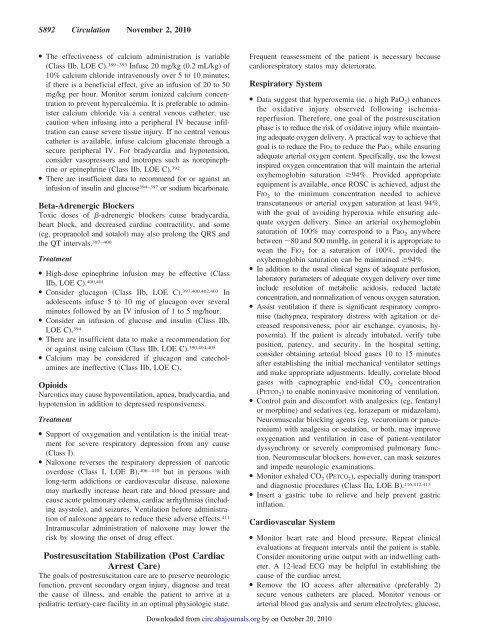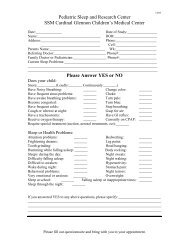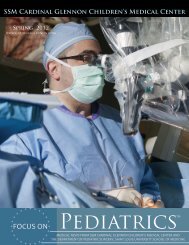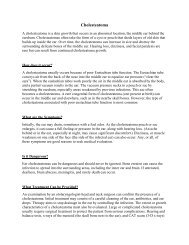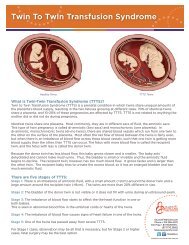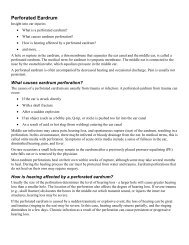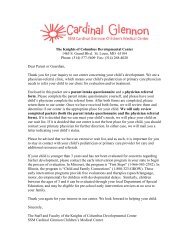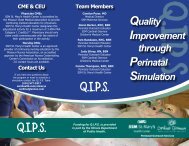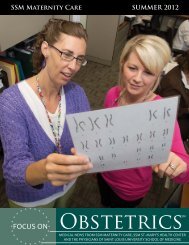pediatric-ALS-AHA-guidelines-circulation_11-2010 - SSM Cardinal ...
pediatric-ALS-AHA-guidelines-circulation_11-2010 - SSM Cardinal ...
pediatric-ALS-AHA-guidelines-circulation_11-2010 - SSM Cardinal ...
You also want an ePaper? Increase the reach of your titles
YUMPU automatically turns print PDFs into web optimized ePapers that Google loves.
S892 Circulation November 2, <strong>2010</strong>● The effectiveness of calcium administration is variable(Class IIb, LOE C). 389–393 Infuse 20 mg/kg (0.2 mL/kg) of10% calcium chloride intravenously over 5 to 10 minutes;if there is a beneficial effect, give an infusion of 20 to 50mg/kg per hour. Monitor serum ionized calcium concentrationto prevent hypercalcemia. It is preferable to administercalcium chloride via a central venous catheter; usecaution when infusing into a peripheral IV because infiltrationcan cause severe tissue injury. If no central venouscatheter is available, infuse calcium gluconate through asecure peripheral IV. For bradycardia and hypotension,consider vasopressors and inotropes such as norepinephrineor epinephrine (Class IIb, LOE C). 392● There are insufficient data to recommend for or against aninfusion of insulin and glucose 394–397 or sodium bicarbonate.Beta-Adrenergic BlockersToxic doses of -adrenergic blockers cause bradycardia,heart block, and decreased cardiac contractility, and some(eg, propranolol and sotalol) may also prolong the QRS andthe QT intervals. 397–400Treatment● High-dose epinephrine infusion may be effective (ClassIIb, LOE C). 400,401● Consider glucagon (Class IIb, LOE C). 397,400,402,403 Inadolescents infuse 5 to 10 mg of glucagon over severalminutes followed by an IV infusion of 1 to 5 mg/hour.● Consider an infusion of glucose and insulin (Class IIb,LOE C). 394● There are insufficient data to make a recommendation foror against using calcium (Class IIb, LOE C). 390,404,405● Calcium may be considered if glucagon and catecholaminesare ineffective (Class IIb, LOE C).OpioidsNarcotics may cause hypoventilation, apnea, bradycardia, andhypotension in addition to depressed responsiveness.Treatment● Support of oxygenation and ventilation is the initial treatmentfor severe respiratory depression from any cause(Class I).● Naloxone reverses the respiratory depression of narcoticoverdose (Class I, LOE B), 406–410 but in persons withlong-term addictions or cardiovascular disease, naloxonemay markedly increase heart rate and blood pressure andcause acute pulmonary edema, cardiac arrhythmias (includingasystole), and seizures. Ventilation before administrationof naloxone appears to reduce these adverse effects. 4<strong>11</strong>Intramuscular administration of naloxone may lower therisk by slowing the onset of drug effect.Postresuscitation Stabilization (Post CardiacArrest Care)The goals of postresuscitation care are to preserve neurologicfunction, prevent secondary organ injury, diagnose and treatthe cause of illness, and enable the patient to arrive at a<strong>pediatric</strong> tertiary-care facility in an optimal physiologic state.Frequent reassessment of the patient is necessary becausecardiorespiratory status may deteriorate.Respiratory System● Data suggest that hyperoxemia (ie, a high PaO 2 ) enhancesthe oxidative injury observed following ischemiareperfusion.Therefore, one goal of the postresuscitationphase is to reduce the risk of oxidative injury while maintainingadequate oxygen delivery. A practical way to achieve thatgoal is to reduce the FIO 2 to reduce the PaO 2 while ensuringadequate arterial oxygen content. Specifically, use the lowestinspired oxygen concentration that will maintain the arterialoxyhemoglobin saturation 94%. Provided appropriateequipment is available, once ROSC is achieved, adjust theFIO 2 to the minimum concentration needed to achievetranscutaneous or arterial oxygen saturation at least 94%,with the goal of avoiding hyperoxia while ensuring adequateoxygen delivery. Since an arterial oxyhemoglobinsaturation of 100% may correspond to a PaO 2 anywherebetween 80 and 500 mmHg, in general it is appropriate towean the FIO 2 for a saturation of 100%, provided theoxyhemoglobin saturation can be maintained 94%.● In addition to the usual clinical signs of adequate perfusion,laboratory parameters of adequate oxygen delivery over timeinclude resolution of metabolic acidosis, reduced lactateconcentration, and normalization of venous oxygen saturation.● Assist ventilation if there is significant respiratory compromise(tachypnea, respiratory distress with agitation or decreasedresponsiveness, poor air exchange, cyanosis, hypoxemia).If the patient is already intubated, verify tubeposition, patency, and security. In the hospital setting,consider obtaining arterial blood gases 10 to 15 minutesafter establishing the initial mechanical ventilator settingsand make appropriate adjustments. Ideally, correlate bloodgases with capnographic end-tidal CO 2 concentration(PETCO 2 ) to enable noninvasive monitoring of ventilation.● Control pain and discomfort with analgesics (eg, fentanylor morphine) and sedatives (eg, lorazepam or midazolam).Neuromuscular blocking agents (eg, vecuronium or pancuronium)with analgesia or sedation, or both, may improveoxygenation and ventilation in case of patient-ventilatordyssynchrony or severely compromised pulmonary function.Neuromuscular blockers, however, can mask seizuresand impede neurologic examinations.● Monitor exhaled CO 2 (PETCO 2 ), especially during transportand diagnostic procedures (Class IIa, LOE B). <strong>11</strong>6,412,413● Insert a gastric tube to relieve and help prevent gastricinflation.Cardiovascular System● Monitor heart rate and blood pressure. Repeat clinicalevaluations at frequent intervals until the patient is stable.Consider monitoring urine output with an indwelling catheter.A 12-lead ECG may be helpful in establishing thecause of the cardiac arrest.● Remove the IO access after alternative (preferably 2)secure venous catheters are placed. Monitor venous orarterial blood gas analysis and serum electrolytes, glucose,Downloaded from circ.ahajournals.org by on October 20, <strong>2010</strong>


